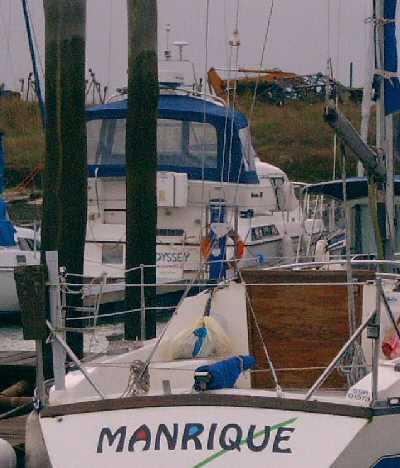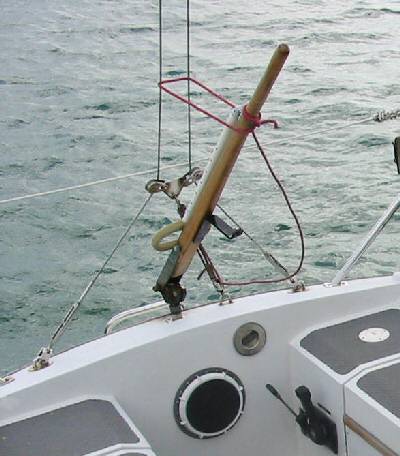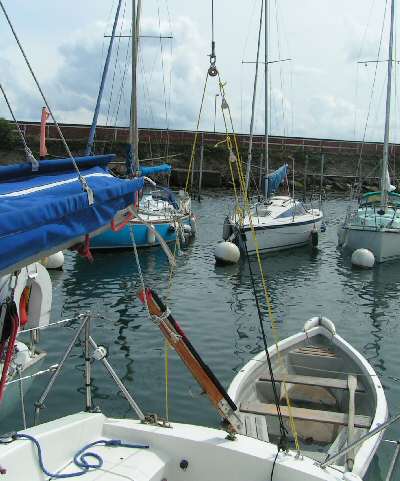
Manrique has a single wire coming from
the back of the mast, then doubles 2 metres from the transom,
with bottlescrews on each wire. The tightening device compresses
the wires together, a bit like a Spanish Windlass. |
 |

Woolfee also uses the same technique,
and the tightening device can be seen in more detail. What I
like about this system is that even if the tightening device
fails, the backstay is still holding the mast up. The down side
is that it is easy to get the initial tightening, but as you
get further down, it becomes much harder to make small increases
in tension. |

Rosa now has an adjustable backstay,
using a single wire down to where it doubles, then dynema to
make a "cascade" giving a 16:1 purchase. I was going
to do similar to Woolfee and Manrique, but given that the doubling
wire had a busting strand, it was easier to replace with dynema.
The cascade gives very easy adjustment, and is easy to make
given it is rope. 16: 1 is the most you can do with a cascade,
as if you double again, you run out of space (unless you take
the doublng point higher up the rig).. |
|
Sooper Trooper uses something similar
to Rosa, only has dynema throughout. It also has a 2:1 at
the junction, then I think a 6:1 purchase set of blocks, one
with a cleat, giving 12:1.
So why adjust a backstay at all. Well,
it helps to point if applied hard upwind, as it increases
tension on the forestay, stopping the genoa falling away sideways,
which kills pointing, though increasing speed. It also helps
bend the mast, making the top of the mainsail leech open out,
loosing power (i.e. most use when in wind). Off the wind it
can be eased to help get the mast as upright as possible,
which gives best speed. If cruising, why bother about speed
/ pointing. Well, just by pointing 10 degrees lower when averaging
about 5 knots upwind, you will probably only travel 2½
miles instead of 3½ miles. Not an issue to those who
turn on the motor under these circumstances!
A note of caution on freeing the backstay.
Rosa has a Furlex roller reefing, and the forestay is inside
the furling foil. If the forestay becomes too slack, it can
catch on the foil, twisting the wire, which should then be
replaced. An expensive mistake - I now only furl with the
backstay tensioned. Hopefully a mistake I'll only make the
once!
All the boats have U bolts to take the
load into the deck above the transom, not ideal, though it
seems to have lasted for many years in each case. Sooper Trooper
has chain plates from the transom, not the deck. I intend
to do something like that over the winter, though I'm guessing
with swept back spreaders the backstay will never have to
take the full forces on the mast |